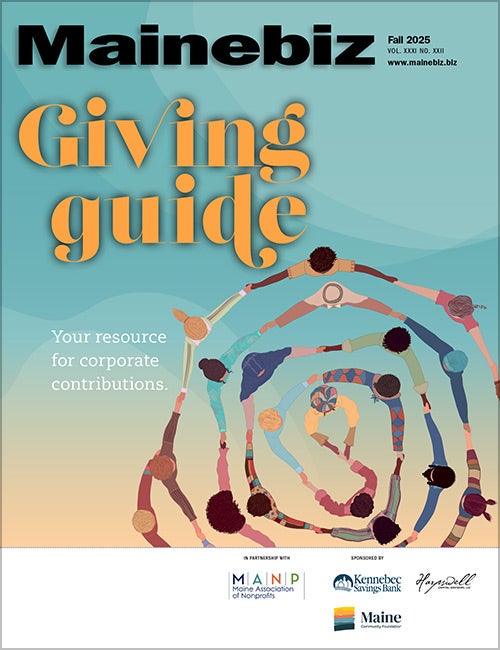
Processing Your Payment
Please do not leave this page until complete. This can take a few moments.
- News
-
Editions
View Digital Editions
Biweekly Issues
- December 1, 2025
- Nov. 17, 2025
- November 03, 2025
- October 20, 2025
- October 6, 2025
- September 22, 2025
- + More
Special Editions
- Lists
- Viewpoints
-
Our Events
Event Info
Award Honorees
- Calendar
- Biz Marketplace
Seeds of thanks: How to create a grateful workplace culture
My client Lesley looks close to tears. She works in a large accounting firm in another state, and though we are separated geographically, her stress is coming through loud and clear.

Spring is always a busy time for accountants, but in her 15 years as team manager in this firm, Lesley claims she has “never experienced anything like the craziness that is happening right now.”
For those of us who do contract coaching work for businesses, it’s hard to miss the increased levels of stress in working culture. Whether as a result of an uncertain business climate, radical political policy change or simply the usual increased activity in a normal business cycle, anxiety has gotten amplified, and clients are feeling the strain.
I ask Lesley if I can offer a suggestion, and I take a deep breath because I’m about to propose something strongly counter-intuitive. At her Monday morning team meeting, I invite her to begin the session with a short ritual in gratitude. She looks at me like I’ve lost my mind, but here’s why.
Reduction in neurochemical stress
A study by the University of California-Berkeley found that gratitude practices significantly reduce cortisol levels. Participants practicing gratitude showed a 23% reduction in stress hormones, resulting in decreased anxiety and improved emotional resilience.
Cognitive reframing
Research in the Journal of Positive Psychology reveals that gratitude journaling helps employees reframe challenges more constructively. After just three weeks, participants demonstrated a 30% increase in their ability to manage workplace challenges by reducing negative rumination.
Social support and workplace connection
Harvard Business Review research highlights gratitude's role in building supportive workplace networks. Studies found that employees who regularly express and receive gratitude report 40% lower burnout rates, improved team cohesion, and more effective collaborative relationships.
I shared with Lesley that I use gratitude practice as a warm-up stress reducer prior to public speaking, for the simple reason that our brains cannot hold both gratitude and toxic stress at the same time.
Here’s some simple suggestions for intentional gratitude in your workplace:
Personalized recognition moments: Implement specific, personalized recognition that goes beyond generic praise. During team meetings, acknowledge individual contributions with detailed, impact-focused comments. Instead of "Great job," try specific praise like, "Sarah's market research helped us secure the Johnson account, boosting our quarterly revenue."
Gratitude journaling and sharing: Introduce a weekly 5 to 10 minute journaling initiative where team members write three things they're grateful for professionally. Encourage voluntary sharing during check-ins to shift focus from challenges to appreciation, improving team morale and creating a supportive environment.
Thank you notes: Craft handwritten or digital thank you notes that are specific and heartfelt, highlighting unique contributions. For example: "Your creativity in resolving the client's technical issue saved the project and showcased your exceptional problem-solving skills." Genuine messages create lasting positive impressions.
Feedback and growth: Transform performance reviews into gratitude-centered conversations. Begin by genuinely appreciating the employee's efforts and strengths before discussing improvement areas. This approach creates a supportive atmosphere where employees feel valued and are more receptive to feedback. Example: "I'm grateful for your initiative in streamlining our project management process, and I'd like to discuss how we can further develop these strengths."
As with any new routine, Lesley will encounter negative reactions and pushback. But I encouraged her to try it for three of the weekly meetings, and to note any changes in attitude on her team at the end of three weeks. I also offered to conduct the first session for her team at half my hourly rate just to get things started. Oftentimes, new strategies are more effective when an unfamiliar person introduces them.
Intentional gratitude in the workplace is not about forced positivity, but about creating genuine connections, recognizing individual contributions and fostering a supportive, appreciative work culture. I feel confident that these strategies can improve employee engagement, motivation and overall workplace satisfaction, even in a busy accounting firm at the height of their season.
About the author
Kym Dakin-Neal is director of Voice Into Learning LLC and a certified coach specializing in effective communications. She can be reached at kdakin56@gmail.com.
Mainebiz web partners
Related Content

The Giving Guide
The Giving Guide helps nonprofits have the opportunity to showcase and differentiate their organizations so that businesses better understand how they can contribute to a nonprofit’s mission and work.
Learn More
Work for ME
Work for ME is a workforce development tool to help Maine’s employers target Maine’s emerging workforce. Work for ME highlights each industry, its impact on Maine’s economy, the jobs available to entry-level workers, the training and education needed to get a career started.
Learn More
Groundbreaking Maine
Whether you’re a developer, financer, architect, or industry enthusiast, Groundbreaking Maine is crafted to be your go-to source for valuable insights in Maine’s real estate and construction community.
Learn more-
The Giving Guide
The Giving Guide helps nonprofits have the opportunity to showcase and differentiate their organizations so that businesses better understand how they can contribute to a nonprofit’s mission and work.
-
Work for ME
Work for ME is a workforce development tool to help Maine’s employers target Maine’s emerging workforce. Work for ME highlights each industry, its impact on Maine’s economy, the jobs available to entry-level workers, the training and education needed to get a career started.
-
Groundbreaking Maine
Whether you’re a developer, financer, architect, or industry enthusiast, Groundbreaking Maine is crafted to be your go-to source for valuable insights in Maine’s real estate and construction community.
ABOUT
NEW ENGLAND BUSINESS MEDIA SITES
No articles left
Get access now
In order to use this feature, we need some information from you. You can also login or register for a free account.
By clicking submit you are agreeing to our cookie usage and Privacy Policy
Already have an account? Login
Already have an account? Login
Want to create an account? Register
Get access now
In order to use this feature, we need some information from you. You can also login or register for a free account.
By clicking submit you are agreeing to our cookie usage and Privacy Policy
Already have an account? Login
Already have an account? Login
Want to create an account? Register









0 Comments